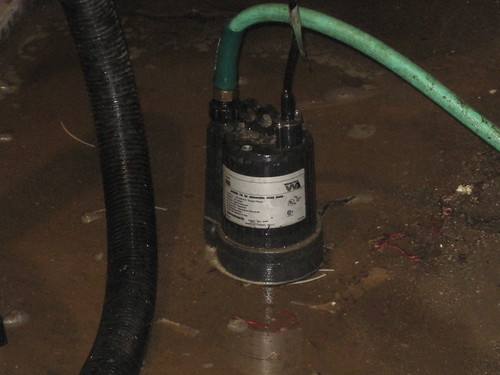Started my Sunday, pretty typical, hanging with the kids etc. Thunderstorms had kicked in and we had one of the hardest rains in Philly in a very long time. Having a fairly old house by US standards comes with flooding wet basements from time to time. As you can imagine the clean up side of the story was less than fun.
I purchased a submersible pump (Water Ace Model R6S) model from Lowe's or Home Depot a few years ago for just such an occasion. Fortunately, I have only needed to use it only a few times and it has saved me a ton of aggravation. It is amazing the volume of water that can accumulate in a very short time. I bet I pumped a few 100 gallons in less than an hour. It got me thinking of all the pump engineers I have spoken to over the years and it was really cool to use a device where some engineer somewhere in the world designed it so that it just worked. Maybe, just maybe CFdesign (or some CFD software) played a contributing factor on the design.

I purchased a submersible pump (Water Ace Model R6S) model from Lowe's or Home Depot a few years ago for just such an occasion. Fortunately, I have only needed to use it only a few times and it has saved me a ton of aggravation. It is amazing the volume of water that can accumulate in a very short time. I bet I pumped a few 100 gallons in less than an hour. It got me thinking of all the pump engineers I have spoken to over the years and it was really cool to use a device where some engineer somewhere in the world designed it so that it just worked. Maybe, just maybe CFdesign (or some CFD software) played a contributing factor on the design.

Check out the pump above in action. Got me also thinking, about my expectations as a consumer of what appears to be a simple device. I want to just stick it in the watery/muddy mess and turn it on and miraculously it just works. Fact is, that is basically what has happened, every time I used it. But in reality, what appears to be a simple device is pretty sophisticated. It has moving parts internally, tight clearances and is expected to prime itself and pump "whatever". Obviously the rain water gets mixed with the sand and dirt from my cellar floor as well as all kinds of debris it picks up along the way. There is a very simple screen on the suction side that allows the debris to collect in a pile instead of being suctioned into the impeller etc. But, watching the discharge end its pretty obvious that this "simple" pump is working it and pumping all kinds of stuff.


Not trivial stuff to design, obviously. We have worked with the folks at Pentair Pumps (parent company of Water Ace folks) for a few years as well as many other pump manufactures.
Take, Cornell Pumps shown above for example, we have helped them reduce the amount of prototyping. There is a long list of things Upfront CFD can do to help such as providing flow rate, pressure head, performance curve data, efficiencies and torque to name a few of the basics. But where we really help is seeing inside the device, which simply can't be seen in a testing environment.
At the end of the day, the cleanup was no fun at all. But it always brings a smile to see products designed by mechanical engineers that just work as expected, easy to forget the blood, sweat and tears that was put into the design.
Take, Cornell Pumps shown above for example, we have helped them reduce the amount of prototyping. There is a long list of things Upfront CFD can do to help such as providing flow rate, pressure head, performance curve data, efficiencies and torque to name a few of the basics. But where we really help is seeing inside the device, which simply can't be seen in a testing environment.
At the end of the day, the cleanup was no fun at all. But it always brings a smile to see products designed by mechanical engineers that just work as expected, easy to forget the blood, sweat and tears that was put into the design.
2 comments:
I had 2 of those same pumps running in the basement at my last house on a regular basis. Pretty impressive when you think about it... no technical background required at all to use them, but quite a precise piece of equipment on the guts.
Had my own run-in with a pump this weekend. The outlet pump of my washing machine quite working. I manfully took everything apart and stuck my finger in the inlet.
Turns out one of my metal collar stays got sucked in there and jammed it up.
After I pulled that out, that puppy started working again no problem. Amazing!
Hi.Really liked your post though most of it sounds very technical to my accounting infested mind. and also thanks for stopping over and commenting on this blog post "Ubuntu Apple is a different ball game" here http://short.ie/foss. Very insightful to read your thoughts. Cheers
Post a Comment